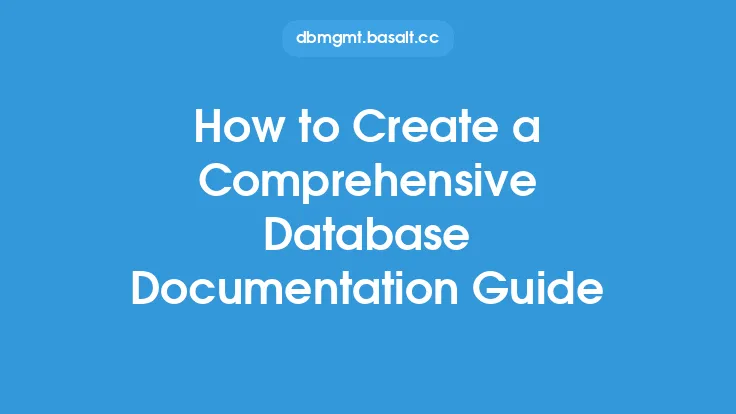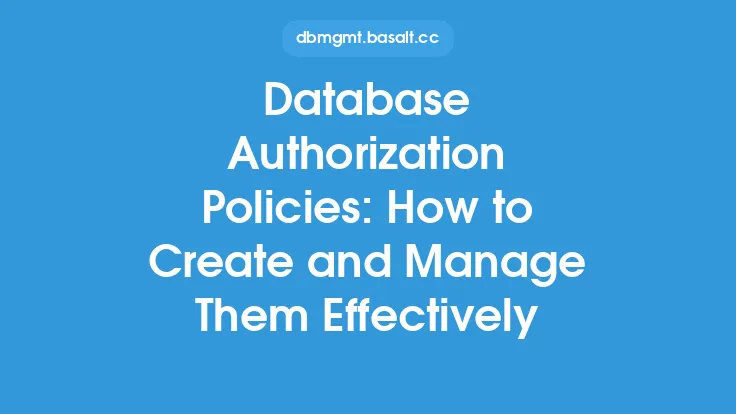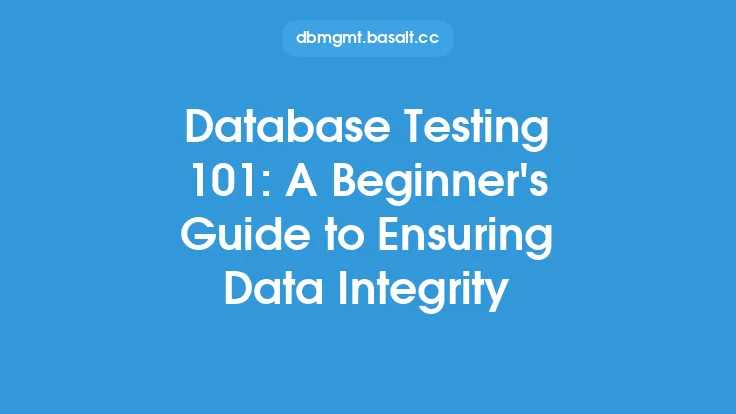Creating a comprehensive database testing plan is a crucial step in ensuring the reliability, performance, and security of a database system. A well-structured testing plan helps identify and fix errors, ensures data integrity, and optimizes system performance. In this article, we will delve into the key components of a comprehensive database testing plan, providing a detailed guide on how to create one.
Introduction to Database Testing Plans
A database testing plan is a document that outlines the approach, scope, and timeline for testing a database system. It serves as a roadmap for the testing process, ensuring that all aspects of the database are thoroughly tested and validated. A comprehensive database testing plan should include the following elements: test objectives, scope, test environment, test data, test cases, test scripts, and test deliverables.
Identifying Test Objectives
The first step in creating a comprehensive database testing plan is to identify the test objectives. Test objectives define what needs to be tested and what the testing process aims to achieve. Common test objectives for database testing include:
- Ensuring data integrity and consistency
- Validating database performance and scalability
- Verifying database security and access control
- Testing database backup and recovery procedures
- Ensuring compliance with regulatory requirements
Defining the Scope of Testing
The scope of testing defines what aspects of the database system will be tested. This includes the database management system, database schema, data models, stored procedures, triggers, and views. The scope of testing should also include the testing of database interfaces, such as user interfaces, application programming interfaces (APIs), and data exchange interfaces.
Setting Up the Test Environment
The test environment is a critical component of the database testing plan. It should mimic the production environment as closely as possible, including the hardware, software, and network configurations. The test environment should also include the necessary tools and utilities for testing, such as database management tools, testing frameworks, and data generation tools.
Creating Test Data
Test data is essential for database testing, as it allows testers to simulate real-world scenarios and test the database system under various conditions. Test data should be representative of the production data, including the data types, formats, and volumes. Test data can be generated using various techniques, such as data masking, data profiling, and data synthesis.
Developing Test Cases
Test cases are the backbone of the database testing plan, as they define the specific tests that will be executed. Test cases should be developed based on the test objectives and scope of testing, and should include the following elements:
- Test case ID and description
- Test case objective and scope
- Pre-conditions and post-conditions
- Test steps and expected results
- Test data and environment requirements
Creating Test Scripts
Test scripts are the automated versions of test cases, and are used to execute the tests repeatedly and efficiently. Test scripts can be written using various programming languages, such as SQL, Python, or Java, and should include the necessary logic and validation to ensure that the tests are executed correctly.
Executing and Reporting Test Results
The final step in the database testing plan is to execute the tests and report the results. Test results should be documented and analyzed to identify defects and areas for improvement. The test results should also be used to refine the testing process and improve the overall quality of the database system.
Best Practices for Database Testing Plans
To ensure that the database testing plan is comprehensive and effective, the following best practices should be followed:
- Involve stakeholders from various teams, including development, quality assurance, and operations
- Use a risk-based approach to testing, focusing on the most critical aspects of the database system
- Use automated testing tools and frameworks to improve efficiency and reduce costs
- Use data analytics and visualization techniques to analyze test results and identify trends
- Continuously review and refine the testing process to ensure that it remains relevant and effective
Common Challenges and Solutions
Despite the importance of database testing plans, there are several challenges that can arise during the testing process. Some common challenges include:
- Insufficient test data and environment resources
- Limited testing time and budget
- Inadequate testing tools and frameworks
- Difficulty in reproducing defects and issues
- Limited visibility and communication among stakeholders
To overcome these challenges, the following solutions can be implemented:
- Use cloud-based testing environments and tools to reduce costs and improve scalability
- Use automated testing frameworks and tools to improve efficiency and reduce testing time
- Use data masking and synthesis techniques to generate test data
- Use collaboration and communication tools to improve visibility and communication among stakeholders
- Use risk-based testing approaches to focus on the most critical aspects of the database system.
Conclusion
Creating a comprehensive database testing plan is a critical step in ensuring the reliability, performance, and security of a database system. By following the guidelines and best practices outlined in this article, database administrators and testers can develop a robust testing plan that covers all aspects of the database system. Remember to continuously review and refine the testing process to ensure that it remains relevant and effective, and to use automated testing tools and frameworks to improve efficiency and reduce costs. With a well-structured database testing plan, organizations can ensure that their database systems are thoroughly tested and validated, and that they meet the required standards for performance, security, and compliance.





